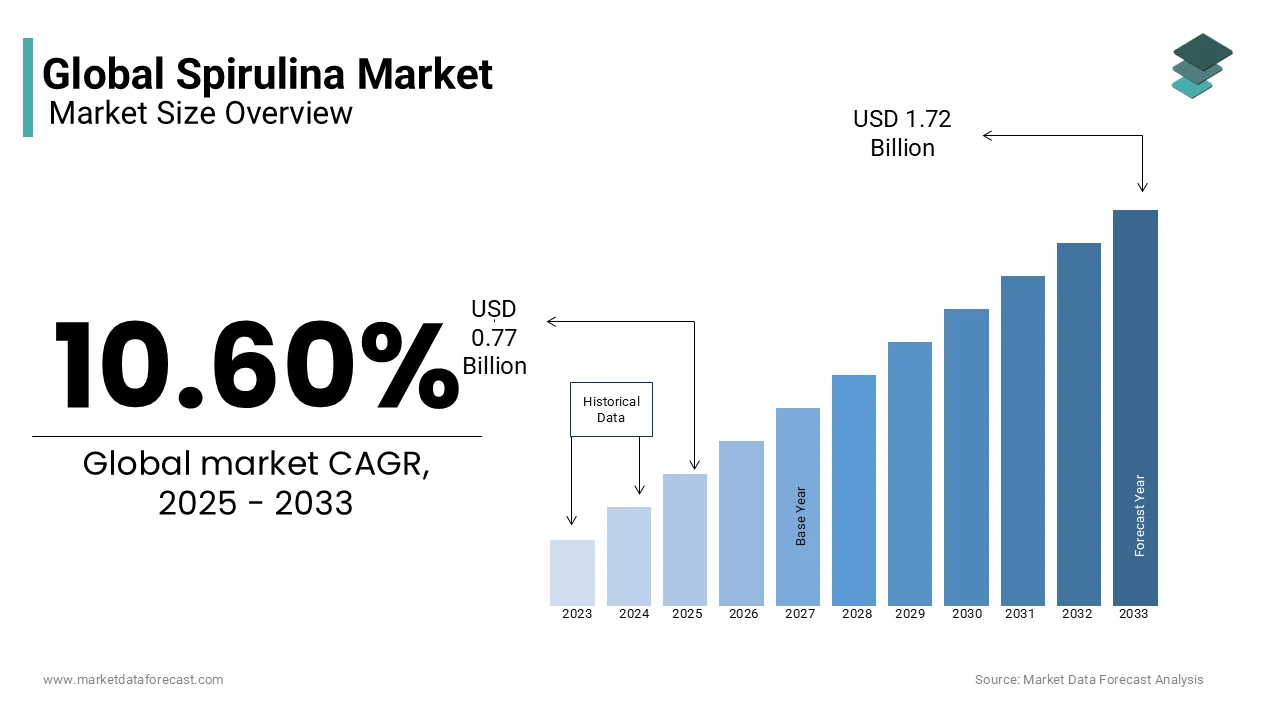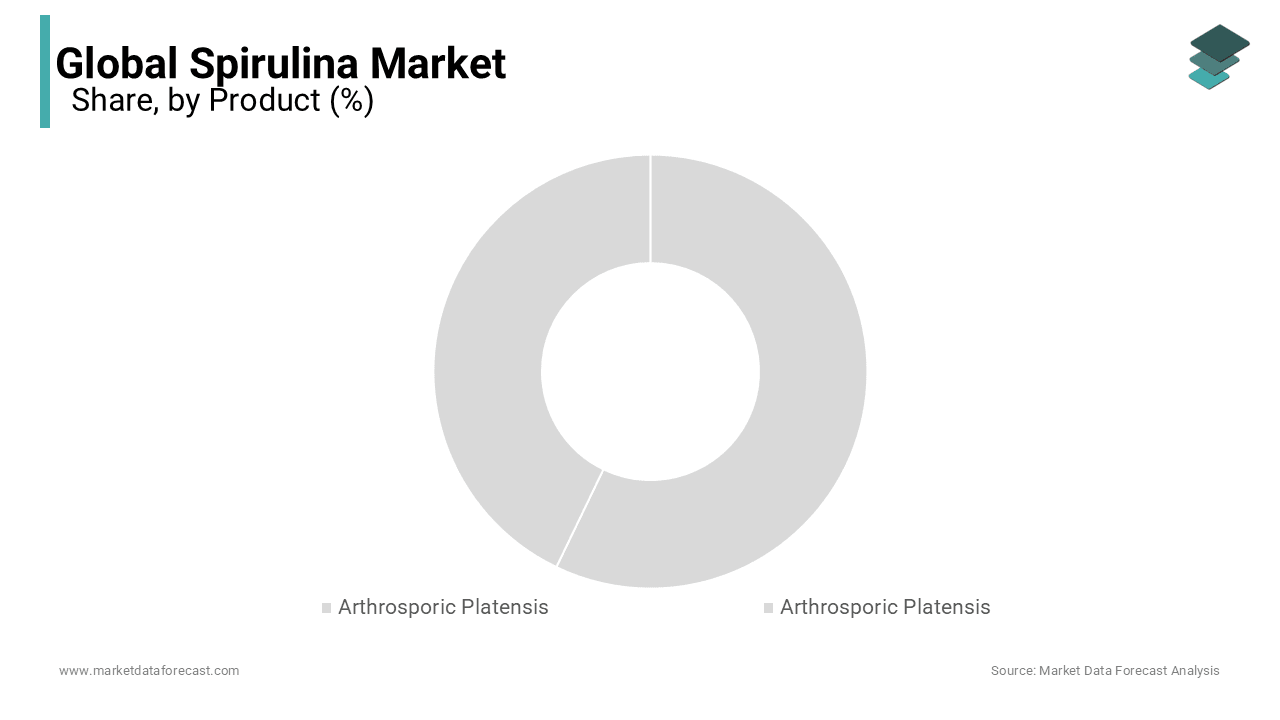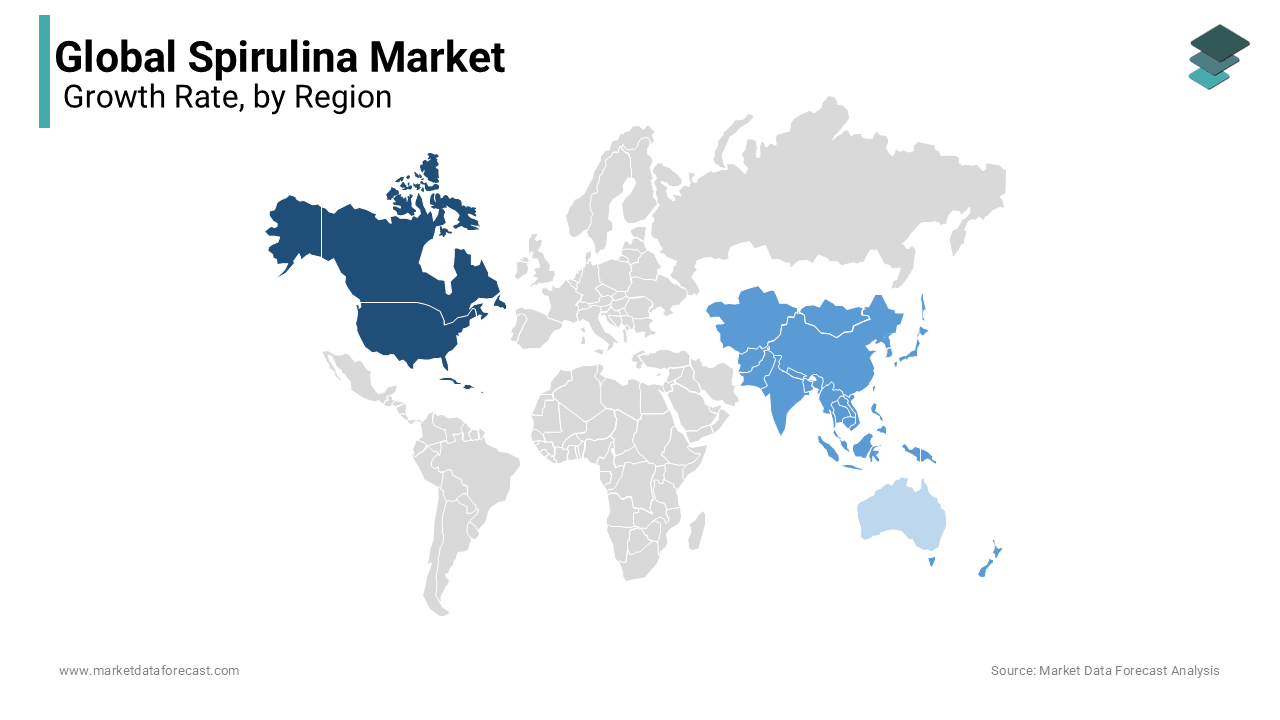Global Spirulina Market Size, Share, Trends, & Growth Forecast Report - Segmented By Type (Arthrospira Platensis and Arthrospira Maxima), Application (Nutraceuticals, Cosmetics, Food & Beverages, Animal Feed, and Others) and Region (North America, Europe, Asia Pacific, Latin America, And Middle East & Africa) – Industry Analysis (2025 to 2033)
Global Spirulina Market Size
The global spirulina market size was valued at USD 0.70 billion in 2024. The global market size is expected to reach USD 1.72 billion by 2033 from USD 0.77 billion in 2025. The market is promising CAGR for the predicted period is 10.60%.

Current Scenario of the Global Spirulina Market
Spirulina is a filament and microscopic cyanobacteria, and its name comes from a spiral or spiral filament structure. This spirulina has been used as a source of protein and vitamin supplements for humans without serious side effects. Along with vitamins, pro-vitamin A, and minerals, especially iron, it has a protein content of more than 70%. Spirulina contains high antioxidant, hyperlipidemic, beta-carotene and anti-inflammatory properties. It provides health benefits, including reduced cholesterol and blood pressure due to its excellent features. Spirulina is a multicellular and filamentary turquoise microalga that grows naturally in alkaline waters in lakes, ponds and rivers in warm regions. This microalga can be easily harvested and processed and has a reasonably high macro and micronutrient content. The use of spirulina as a protein supplement and healthy food for human health has gained considerable popularity in the human health food industry in developing and developing countries, such as India and Africa, where malnutrition prevails. This microalga can also be used as a dietary ingredient in poultry feed and is increasingly used as a protein and vitamin supplement for fish. Spirulina is one of the most ancient forms of life on earth that produces oxygen in the atmosphere of the planet. It is considered a superfood and one of the richest in nutrients in the world. It contains between 55 and 70% protein, eight essential and 10 non-essential amino acids, chlorophyll, beta-carotene, DNA & RNA nuclear acids, and other important gamma-linolenic acids.
MARKET DRIVERS
The growing awareness of the health properties of spirulina and the increasing popularity of spirulina powder are propelling the global market's growth. Several researchers have recently claimed that spirulina has anti-cancer properties. Animal research has been the basis of this claim. The growth of the spirulina market is expected in the years to come as a consequence of their contribution to weight reduction and an increasing number of health clubs and fitness centers. Cyanobacteria's health benefits contributed to their dessert use, smoothies, juices, salads and breakfast foods. Spirulina powder is needed for different treatments, including anti-aging, wrinkles, gray hair, hair loss, and allergies. The market for skin and hair care requires Spirulina powder, along with several pharmaceutical products, is used in a variety of treatments in the medical industry. Due to a growing awareness of the benefits to the health of spirulina superfood among consumers and a wide range of natural spirulina colors, the global spirulina market volume is expected to be fuelled in the near future. The government of countries such as India and South Africa also promotes spirulina production, taking into account its health benefits, which contribute to fueling growth in the spirulina market. Lower stability and poor sustainability of the spirulina natural colors are anticipated to hamper the market growth during the forecast period compared with synthetic colors and strict government regulations. Conversely, untapped markets in developing countries are expected to provide lucrative opportunities for the market players. The impact of the driving factors is expected to surpass that of the restraints.
The growing usage of spirulina powder in the food and beverage industry is further boosting the growth rate of the global spirulina market. Spirulina is essentially a cyanobacterium that grows in salt and freshwater and belongs to a group of turquoise algae or single-celled microbes. Spirulina in powder form is used in various industries. Therefore, the global spirulina powder market has a broad consumer base that contributes to the overall growth of this business. A tablespoon of spirulina contains about 1 gram of fat, including omega-3 and omega-6 fatty acids. Additionally, spirulina is rich in protein, and the protein quality of spirulina is similar to that of eggs. The latter is considered very useful for the human body because one tablespoon of spirulina powder and 11% iron contains 4 g of protein. Spirulina also contains vitamin B1, vitamin B2, and vitamin B3. As the demand for cyanobacteria increases, as it contributes to weight loss and the number of health clubs and gyms increases, the growth of the spirulina market is expected to accelerate in the future. The health benefits of cyanobacteria helped find usage in desserts, smoothies, juices, salads, and breakfasts. The skin and hair care market demands spirulina powder included in a variety of treatments, including anti-aging, wrinkles, grey hair, hair loss, and allergies. In the medical industry, spirulina powder is used in a range of treatments with a variety of medications. The global spirulina market is supposed to kick in the near future as consumers will soon realize the health benefits of spirulina superfood and the various natural colors produced by spirulina. In addition, national governments such as India and South Africa are promoting spirulina production, taking into account the health benefits that can help accelerate the growth of the spirulina business. On the contrary, underdeveloped markets in developing countries are assumed to offer market players a favorable opportunity. The impact of driving factors is expected to outweigh the effect of the constraint.
MARKET RESTRAINTS
Strict government regulations and the stability and low sustainability of spirulina-derived natural colors are hampering the growth of the spirulina market. Limited spirulina resources, extracted from freshwater sources available in very few regions, impede the market growth. Due to unfavorable weather conditions and the use of expensive production technologies, the cost of production in developed countries remains high compared to emerging countries. On the other hand, spirulina prices are low in Asian countries due to favorable weather conditions, low production costs and the presence of many local companies offering cheap products on the market.
REPORT COVERAGE
|
REPORT METRIC |
DETAILS |
|
Market Size Available |
2024 to 2033 |
|
Base Year |
2024 |
|
Forecast Period |
2025 to 2033 |
|
CAGR |
10.60% |
|
Segments Covered |
By Type, Application, and Region |
|
Various Analyses Covered |
Global, Regional and Country Level Analysis; Segment-Level Analysis; DROC; PESTLE Analysis; Porter’s Five Forces Analysis; Competitive Landscape; Analyst Overview of Investment Opportunities |
|
Regions Covered |
North America, Europe, APAC, Latin America, Middle East & Africa |
|
Market Leaders Profiled |
Cyanotech Company, DIC Corporation, Chr. Hansen Holding A / S, Sensient Technologies Corporation, Parry Neutraces, DDW Inc, Algenol Biofuels Inc, Prolgae, Naturex, S.A , Algatec |
SEGMENTAL ANALYSIS
By Type Insights
Due to factors such as the increase in healthcare and the inclusiveness of spirulina into diets as superfoods worldwide, the Arthrosporic Platensis segment was the largest contributor to revenues in 2018 and is expected to remain dominant throughout the forecast period.

By Application Insights
The nutraceuticals segment led the market in 2023 and is predicted to account for the major share of the global spirulina market during the forecast period. This is because nutrition and health care are growing and the preference for natural alternatives to traditional pharmaceuticals is increasing. Spirulina also is used primarily in food & drinks because it has a high natural color content that gives the color blue and blends it with other colors to achieve new personalized colors such as lavender, violet, and yellow. In the cosmetic & personal care sector, it also finds its main use. It is also mainly used in cosmetic and personal care products, especially the anti-aging cream.
REGIONAL ANALYSIS
North America was the primary source of income for the worldwide spirulina market in 2023, and it is foreseen to maintain its dominant position throughout the projection period. At the regional level, the global spirulina market analysis is carried out in North America, Europe, Asia Pacific, and LAMEA. North America and Europe are the leading producers of spirulina extract due to favorable weather conditions and a wide range of products. The North American spirulina extract market shows the United States as the dominant country and Canada as a dynamic market, taking into account the changes in the regulated markets and the changes implemented by the leading market players. As a food industry dye, the chemical ban makes the United States and Europe a booming market.

Spirulina markets in the Asia Pacific, especially China, India, and Japan, are foreseen to show high growth during the forecast period. Demand for clean labels and natural ingredients is anticipated to lead the market during the prediction period. The Asia Pacific region is likely to grow at the highest annual growth rate during the estimated period, as strong growth in the food processing industry offers favorable opportunities for market participants. Also, since spirulina is a 100% vegetarian supplement, the growing demand for spirulina powder among vegetarian consumers is another factor driving growth in this market.
KEY PLAYERS IN THE SPIRULINA MARKET
Cyanotech Company, DIC Corporation, Chr. Hansen Holding A / S, Sensient Technologies Corporation, Parry Neutraces, DDW Inc, Algenol Biofuels Inc, Prolgae, Naturex, S.A. and Algatec are some of the major players in the global spirulina market.
RECENT HAPPENINGS IN THE MARKET
- In July 2020, Global EcoPower (GEP) completed the purchase of Tam’s spirulina production and marketing assets as it continues to operate in sustainable agriculture. TAM was the first spirulina producer through the CYANE brand in France, where the company said it had developed the first unit of the country for organic greenhouse cultivation and marketing of spirulina.
- Just Energy, Ohio has been seeking more funding statewide to study these methods and extract oil from the microalgae.
- The United States Department of Energy is spending money to increase the viability and efficiency of using algae for fuel. They announced $ 18 million to produce algae biofuels.
MARKET SEGMENTATION
This research report on the global Spirulina Market has been segmented and sub-segmented based on Product, Application and region.
By Type
- Arthrosporic Platensis
- Arthrosporic Platensis
By Application
- Nutraceuticals
- Cosmetics
- Food and Drink
- Livestock
- Feeding
- Other
By Region
- North America
- Europe
- The Asia Pacific
- Latin America
- Middle East and Africa
Frequently Asked Questions
1. What is Spirulina?
Spirulina is a type of blue-green algae that grows in freshwater lakes, ponds, and rivers. It is rich in protein, vitamins, minerals, and antioxidants, making it a popular dietary supplement.
2. What are the Health Benefits of Spirulina?
Spirulina is known for its various health benefits, including boosting the immune system, improving energy levels, supporting heart health, and promoting detoxification. It is also rich in antioxidants, which help fight oxidative stress and inflammation in the body.
3. Can Spirulina Help with Weight Loss?
Some studies suggest that spirulina may aid in weight loss by increasing feelings of fullness and reducing appetite. However, more research is needed to confirm its effectiveness for weight management.
Related Reports
Access the study in MULTIPLE FORMATS
Purchase options starting from $ 2500
Didn’t find what you’re looking for?
TALK TO OUR ANALYST TEAM
Need something within your budget?
NO WORRIES! WE GOT YOU COVERED!
Call us on: +1 888 702 9696 (U.S Toll Free)
Write to us: [email protected]